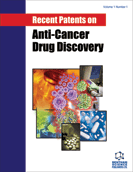Abstract
Flavonoids belong to polyphenolic secondary metabolites with broad-spectrum pharmacological activities and extensive biological effects, and the most prominent activity is their potential role as anticancer agents. In recent years, flavonoids and their synthetic analogues have been intensely investigated in the treatment of ovarian, breast, cervical, pancreatic, and prostate cancer. To some extent, chemical structures of flavonoids will influence their anticancer activities. Thus, some new analogues based on the structural skeleton of these flavonoids have been synthesized and investigated. This review presents recent advances on the patents concerning of the natural flavonoids and their synthetic analogues in the treatment of cancers, and new synthetic approaches and possible structure-activity relationships of flavonoids are also briefly summarized.
Keywords: Anticancer, flavonoids, synthetic analogue, flavones, isoflavone, flavonol, flavanol, anthocyanin, chalcone
Recent Patents on Anti-Cancer Drug Discovery
Title: Flavonoids: Recent Advances as Anticancer Drugs
Volume: 5 Issue: 2
Author(s): Hai L. Liu, Wen B. Jiang and Meng X. Xie
Affiliation:
Keywords: Anticancer, flavonoids, synthetic analogue, flavones, isoflavone, flavonol, flavanol, anthocyanin, chalcone
Abstract: Flavonoids belong to polyphenolic secondary metabolites with broad-spectrum pharmacological activities and extensive biological effects, and the most prominent activity is their potential role as anticancer agents. In recent years, flavonoids and their synthetic analogues have been intensely investigated in the treatment of ovarian, breast, cervical, pancreatic, and prostate cancer. To some extent, chemical structures of flavonoids will influence their anticancer activities. Thus, some new analogues based on the structural skeleton of these flavonoids have been synthesized and investigated. This review presents recent advances on the patents concerning of the natural flavonoids and their synthetic analogues in the treatment of cancers, and new synthetic approaches and possible structure-activity relationships of flavonoids are also briefly summarized.
Export Options
About this article
Cite this article as:
Liu L. Hai, Jiang B. Wen and Xie X. Meng, Flavonoids: Recent Advances as Anticancer Drugs, Recent Patents on Anti-Cancer Drug Discovery 2010; 5 (2) . https://dx.doi.org/10.2174/157489210790936261
| DOI https://dx.doi.org/10.2174/157489210790936261 |
Print ISSN 1574-8928 |
| Publisher Name Bentham Science Publisher |
Online ISSN 2212-3970 |
 19
19
- Author Guidelines
- Bentham Author Support Services (BASS)
- Graphical Abstracts
- Fabricating and Stating False Information
- Research Misconduct
- Post Publication Discussions and Corrections
- Publishing Ethics and Rectitude
- Increase Visibility of Your Article
- Archiving Policies
- Peer Review Workflow
- Order Your Article Before Print
- Promote Your Article
- Manuscript Transfer Facility
- Editorial Policies
- Allegations from Whistleblowers
Related Articles
-
Non-Peptidic GnRH Receptor Antagonists
Current Medicinal Chemistry In Situ Gene Therapy for Prostate Cancer
Current Gene Therapy Editorial [Hot topic: (Part I) Recent Trends in Anti-Cancer Drug Discovery (Guest Editor: Fazlul H. Sarkar)]
Mini-Reviews in Medicinal Chemistry The Estrogenic Burden on Vascular Risk in Male-to-Female Transsexuals
Current Pharmaceutical Design Jumping on the Train of Personalized Medicine: A Primer for Non-Geneticist Clinicians: Part 2. Fundamental Concepts in Genetic Epidemiology
Current Psychiatry Reviews Hedgehog Signaling and Urological Cancers
Current Drug Targets DNA Microarray-Based Gene Expression Profiling in Cancer: Aiding Cancer Diagnosis, Assessing Prognosis and Predicting Response to Therapy
Current Pharmacogenomics Therapeutic Targeting of Apoptotic Pathways in Cancer
Current Drug Targets Structure, Biological Properties and Applications of Marine-derived Polysaccharides
Current Organic Chemistry Advances in Imaging Gene-Directed Enzyme Prodrug Therapy
Current Pharmaceutical Biotechnology Mass Spectrometry Based Proteomics for Interrogating the Histone Code
Current Proteomics Epigenetic Modulation Using Small Molecules - Targeting Histone Acetyltransferases in Disease
Current Medicinal Chemistry Synthesis and Cytotoxicity Studies of New Morpholino-Functionalised and N-Heteroaryl-Substituted Titanocene Anticancer Drugs
Medicinal Chemistry Hepatitis C Treatment in Patients with Drug Addiction: Clinical Management of Interferon-Alpha-Associated Psychiatric Side Effects
Current Drug Abuse Reviews Regulation of Foxo-Dependent Transcription by Post-Translational Modifications
Current Drug Targets Targeting Signal Transduction Pathways in the Treatment of Mood Disorders: Recent Insights into the Relevance of the Wnt Pathway
CNS & Neurological Disorders - Drug Targets Apoptosis-Inducing Effects of Amaryllidaceae Alkaloids
Current Medicinal Chemistry Specific Targeted Therapy: A New Tool for the Destruction of Cancer
Current Drug Therapy Chaperones and Their Role in Telomerase Ribonucleoprotein Biogenesis and Telomere Maintenance
Current Proteomics A Combined Approach with Rituximab Plus Anti-TRAIL-R Agonistic Antibodies for the Treatment of Haematological Malignancies
Current Pharmaceutical Design


























